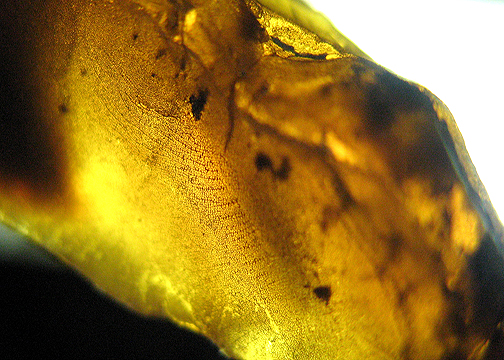Abstract
Ambers in China have been described from the various localities of both Cretaceous (e.g., Xixia amber from Henan Province and Jalainur [Zhalainuoer] amber from northeastern Inner Mongolia) and Palaeogene (e.g., Eocene Fushun amber of Liaoning Province and Miocene Zhangpu amber of Fujian Province) ages to date (e.g., Hong, 1981, 2002; Shi et al., 2014; Wang et al., 2014; Azar et al., 2019; Wang et al., 2021). Here we report a new amber locality from the Late Oligocene of Nanning Basin, Guangxi, southern China. The first amber piece was collected by one of the authors (GCZ) on 5 June 2008. In a recent field work in early 2021, we further discovered more than 50 smaller amber pieces, which are reported here.
References
- Azar, D., Maksoud, S., Cai, C.Y. & Huang, D.Y. (2019) A new amber outcrop from the Lower Cretaceous of northeastern China. Palaeoentomology, 2 (4), 345–349. https://doi.org/10.11646/palaeoentomology.2.4.8
- Chen, G.J., Cen, L.D. & Liu, J. (2017) Cyprinus-like pharyngeal bones and teeth (Teleostei, Cypriniformes, Cyprinidae) from the Early–Middle Oligocene deposits of South China. Vertebrata PalAsiatica, 55, 201–209.
- Chen, G.J., Liu, J. & Chang M.M. (2018) Evolutionary hotspot of Cenozoic fish: Paleogene ichthyofauna from the onshore basins around Beibu Gulf. Chinese Science Bulletin, 63, 2863–2875 [In Chinese]. https://doi.org/10.1360/N972018-00569
- Deng, D. & Wu, Y. (1992) Features of the Palaeogene sedimentary facies of the Nanning Basin, Guangxi. Guangxi Geology, 65, 23–30.
- Guangxi Geology and Mineral Bureau (1985) Regional geology of Guangxi. Beijing, Geological Publishing House. 214–227 [In Chinese].
- Hong, Y.C. (1981) Eocene fossil Diptera Insecta in amber of Fushun Coalfield. Geological Publishing House, Beijing, vi+166 pp [In Chinese].
- Hong, Y.C. (2002) Amber insects of China. Beijing Science and Technology Press, Beijing, 653 pp [In Chinese].
- Huang, L.L., Jin, J.H., Quan, C. & Oskolski, A.A. (2016) Camellia nanningensis sp. nov.: the earliest fossil wood record of the genus Camellia (Theaceae) from East Asia. Journal of Plant Research, 129, 823–831. https://doi.org/10.1007/s10265-016-0846-8
- Liu, C.G. (1999) the Development characteristics of the sedimentary system in the Beihu Sag of the Nanning Basin. Yunnan Geology, 18, 266–274.
- Odhner, N.H.J. (1930) Non-marine Mollusca from Pliocene deposits of Kwangxi, China. Palaeontologia Sinica, Series B, 6 (4), 7–29.
- Shi, G.L., Dutta, S., Paul, S., Wang, B. & Jacques, F.M.B. (2014) Terpenoid compositions and botanical origins of Late Cretaceous and Miocene amber from China. PLoS ONE, 9 (10), e111303. https://doi.org/10.1371/journal.pone.0111303
- Tian, Y., Fürsich, F.T. & Schneider, S. (2013) Giant Viviparidae (Gastropoda: Architaenioglossa) from the Early Oligocene of the Nanning Basin (Guangxi, SE China). Neues Jahrbuch für Geologie und Paläontologie, 267, 75–87. https://doi.org/10.1127/0077-7749/2012/0298
- Tian, Y., Shaw, D. & Schneider, S. (2018) Oligocene fossil assemblages from Lake Nanning (Yongning Formation; Nanning Basin, Guangxi Province, SE China): Biodiversity and evolutionary implications. Palaeogeography, Palaeoclimatology, Palaeoecology, 505, 100–119. https://doi.org/10.1016/j.palaeo.2018.05.033
- Wang, B., Rust, J., Engel, M.S., Szwedo, J., Dutta, S, Nel, A., Fan, Y., Meng, F.W., Shi, G.L., Jarzembowski, E., Wappler, T., Stebner, F., Fang, Y., Mao, L.M., Zheng, D.R. & Zhang, H.C. (2014) A diverse paleobiota in Early Eocene Fushun amber from China. Current Biology, 24, 1606–1610. https://doi.org/10.1016/j.cub.2014.05.048
- Wang, B., Shi, G., Xu, C., Spicer, R.A., Perrichot, V., Schmidt, A.R., Feldberg, K., Heinrichs, J., Chény, C., Pang, H., Liu, X., Gao, T., Wang, Z., Ślipiński, A., Solórzano-Kraemer, M.M., Heads, S.W., Thomas, M.J., Sadowski, E.-M., Szwedo, J., Azar, D., Nel, A., Liu, Y., Chen, J., Zhang, Q., Zhang, Q., Luo, C., Yu, T., Zheng, D., Zhang, H., Engel, M.S. (2021) The mid-Miocene Zhangpu biota reveals an outstandingly rich rainforest biome in East Asia. Science Advances, 7, eabg0625. https://doi.org/10.1126/sciadv.abg0625
- Wang, W.M., Chen, G.J. & Liao, W. (2015) Oligocene palynoflora from Nanning Basin in Guangxi and its paleoenvironmental significance. Quaternary Sciences, 35, 650–659 [In Chinese].
- Zhao, Z.R. (1993) New Anthracothere materials from the Palaeogene of Guangxi. Vertebrata PalAsiatica, 31, 183–190 [In Chinese].


